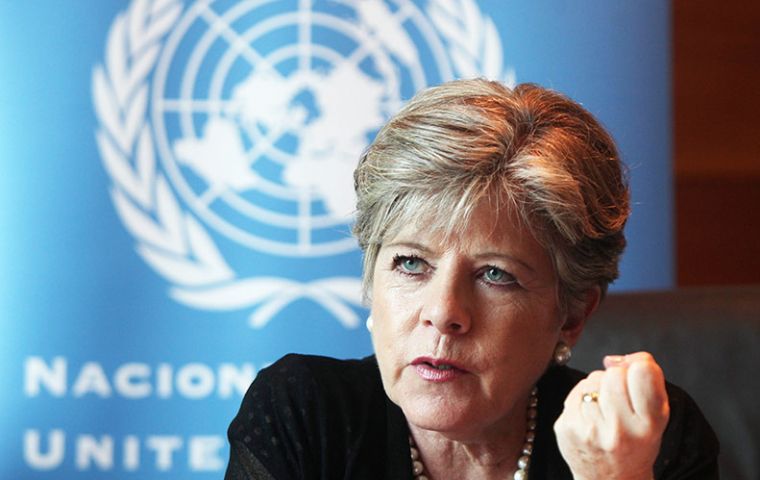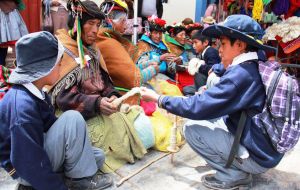MercoPress. South Atlantic News Agency
Latin America's 2013/15 exports, worst performance in eight decades says ECLAC
 “The region is at a crossroads” warns ECLAC’s Alicia Barcena who underlined more international insertion is needed.
“The region is at a crossroads” warns ECLAC’s Alicia Barcena who underlined more international insertion is needed.  ECLAC estimates regional exports will fall again in 2016, because the outlook for a rebound in prices over the next year is not likely.
ECLAC estimates regional exports will fall again in 2016, because the outlook for a rebound in prices over the next year is not likely.  Poverty reduction has stalled across Latin America, barely buddging since 2012, as economic growth has slowed down too
Poverty reduction has stalled across Latin America, barely buddging since 2012, as economic growth has slowed down too The value of Latin America’s exports will continue to decline through 2015 by 14%, with Argentina faring slightly worse with a reduction of 17%, says the UN Economic Commission for Latin America and the Caribbean (ECLAC) report, which also indicated that the value of imports to Argentina are set to fall by a smaller 10%.
ECLAC figures showed that the 2013-2015 period featured the worst regional export performance in the last eight decades, as 2015 marks the third consecutive year that export values fall in the Latin American and Caribbean region, and the second consecutive year that they fall for Argentina.
“The region is at a crossroads: either it continues along the current path restricted by the global context, or it commits to a more active international insertion that favors industrial policy, diversification, trade facilitation and interregional integration,” said ECLAC’s Executive Secretary Alicia Barcena.
She highlighted that the sharp drop in commodity prices and lower international demand for the products that the region exports, have affected its overseas shipments. In 2014 and 2013, for example, they declined three percent and -0.4%, respectively.
According to the United Nations organization, it is likely that regional exports will fall again in 2016, because the outlook for a rebound in prices over the next year is not likely. ECLAC highlighted that the recession that has affected the global economy since 2008-2009, prevented trade from recovering dynamism.
The report outlined various factors that have hindered the regional economy — excess liquidity, the fall of aggregate demand, China’s deceleration, a drop in capital flows towards the region, and an increase in financial instruments that go beyond the real economy.
ECLAC only recently warned about growing problems in Latin America, with a report this year saying that poverty reduction has stalled across the continent, barely budging since 2012, as economic growth has slowed down too following a decade of strong economic growth which led to a rising middle class.
An estimated 28% of the region’s population, or 167 million people, were mired in poverty in 2014. The figure remained stable between 2012 and 2013, when it affected 28.1% of the population. Destitution, meanwhile, rose to 11.7% in 2013 from 11.3% in 2012, which supposes an increase of three million people, raising the total to 69 million.
“It seems countries were unable to sufficiently take advantage of the recovery from the international financial crisis to strengthen social protection policies that reduce vulnerability from economic cycles,” said Alicia Barcena at the time. “Now, in a scenario with a possible reduction of available fiscal resources, more work is needed to strengthen these policies.”
Multiple international organisms have warned this year about the fiscal effects of reduced commodity prices, which will give states less resources to fight poverty and destitution, as demand from China slows down.




Top Comments
Disclaimer & comment rules-

-

-

Read all commentsBut according to (can't) THINK (for himself) everything is normal and rosy: dwindling exports, rampant inflation, a flat-lining economy, fleeing international investors, a Mickey Mouse currency which trades on the black market at almost half the official rate and wage growth (financed by theft, extortion and unsustinable borrowing) which outstrips GDP growth by 50-to-1 are all positive economic indicators and the result of brilliant management of the economy chuckle chuckle chuckle
Oct 22nd, 2015 - 09:36 am 0However for Brazil is the best surplus of the last four years.
Oct 22nd, 2015 - 02:11 pm 0WOW
@ 2 Brasileiro
Oct 22nd, 2015 - 05:19 pm 0That being the only good news for Brazil, with unemployment at a five-year peak. consumer spending in the dumps, a moribund economy and a grinding political crisis that's has rendered Dilma the Marxist terrorist totally impotent.
WOW
Commenting for this story is now closed.
If you have a Facebook account, become a fan and comment on our Facebook Page!